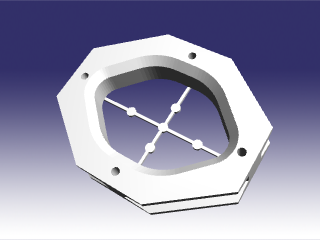
DESIGN: J. Osborne
As multiple labs have developed an interest in the use of head-fixed, behaving rodents for electrophysiology and imaging a number of methods have been adapted to the needs of individual labs, but a general solution does not yet exist. Thus, we sought to develop a general approach suited to a wide array of experiments that optimized several features:
(1) Sufficient stability for electrophysiology and imaging;
(2) Minimized experimental cost;
(3) A flexible design that facilitated customization according to experimental needs;
(4) Capacity to be produced and shared amongst groups easily.
We have developed a system, RIVETS, that provides a flexible platform for experimentation. Our solution attempts to optimize across a number of features including the ability to rapidly convert equipment between multiple experimental approaches, rapid design and customization for new experiments or techniques, low cost and ease of production, all while not sacrificing stability and recording quality. The system provides excellent stability for a range of experiments from extracellular recording to subcellular imaging.

The initial chamber design followed from a simple concept: a chamber needed to provide central access for physiology while providing an outer surface sufficient for stable clamping and holding of position. We reasoned that optimal stability could be achieved using a set of surfaces with 45o angles between surfaces. A set of surfaces on each side of the chamber provides robust holding force directed along all 3 dimensions.

To see more detail about the felxible design of the clamping system and how it is manufactured please see the designs page.
We have typically manufactured the clamps out of stainless steel. Our designs require tight tolerances. We have often contracted an external vendor, Ronal Tool & Die, to manufacture the clamp system and they now have experience producing several different designs. For more details about manufacturing your own clamping system please see the fabrication page.
We designed this system to be a general solution that could be quickly customized to any given experimental need. We and others have now designed a broad variety of chambers used from a variety of experiments spanning electrophysiology, behavior, and imaging. Here we feature a subset of basic types and more details can be found on the designs page.
A number of plastics and designs were tried initially (not shown), however, we have commonly manufactured RIVETS chambers using two types of resin and using commercially available 3D printers. For further details interested users should consult the fabrication page. There we provide a number of details about how to manufacture RIVETS on your own 3D printer or how to contract outside vendors for production.
We have assessed the stability of the RIVETS system using a number of different metrics. We determined the mechanical stability directly, as well as its suitability for performing a broad range of neuroscience experiments. In particular, we were interested in a platform that would allow whole-cell patch clamp recording, two photon imaging, single and multi-unit extracellular recording in behaving animals as well as allowing rapid conversion so that the same experiments could be performed in vitro. All of these techniques have been validated and performed quite extensively both in the Dudman Lab as well as in another of other labs. In the coming weeks we will put more of our validation data up here, for now please consult the associated manuscript.
